Posts filed under 'Main'
I wrote the following post over a year ago for identity.net – but since that blog no longer exists, I want to re-post it here.
One of the most common ways to “hack†into somebody’s account actually doesn’t involve hacking at all. The easiest method is simply to learn some information about them and then use the “forgot username†and “forgot password†features that many sites now offer.
Implemented wrongly, these features can actually be a very big security liability. The right way to do it is to ask the question, then send an email with password reset instructions (but not the actual password). The wrong way is to validate the user and then simply tell them their password.
Why? Because most security questions are very common and easy to figure out – so if I know a little bit about you, I can easily answer them.
What makes a good security question? It’s not just about scarce information, it’s about non-public information.
Some of the most common questions are “What is your high school mascot?†“What city were you born in?†“What’s your favorite pet’s name?†“What was your first street name?†“What was your first phone number?†and “What is your company’s street name?â€
The problem with these questions is that they’re all easily answered on my Facebook page. Birth information is public record – it can easily be looked up. So can my previous addresses, phone number, and where I work. It’s all out there somewhere on the internet.
Better questions are things like “What is your frequent flyer number?†or “what are the last 4 digits of your credit card number?†But even these fail. Many people other than me know my FF number, including my secretary, airline attendants, and TSA employees. The last 4 of your credit card won’t work either since many sites list it as a way to identify transactions.
So what do you do? Simple: Let the user choose their own question.
A good questions should be something that can’t be guessed or looked up, doesn’t change over time, and is easily memorable.
As a user, you should choose something that nobody can easily figure out. My favorite question is “What is your favorite Prime Number?†Another great one I use is something like “Last 3 words on page 15.†It’s useless to you unless you know what book I’m talking about. You could even use a bible here, since there are so many versions in print that it’s almost impossible somebody else will have the same one as you. Another one I once used was “What’s my cell phone serial number?†It’s clearly printed on the back of my phone, and always in my pocket if I should need it. (Just remember to update your question if you get a new cell phone!)
Whether you’re implementing this feature on a website, or simply choosing your own security question – don’t pick something that others can easily guess or look up about you.
February 10th, 2010

In a fit of boredom the other day I went back and started reading questions posed to Matt Cutts in the latest Google Moderator grab bag. If you’re not familiar with this, it’s basically a forum where Matt takes questions from the community and answers them in videos on YouTube.
As I was reading through the questions, one theme kept popping up: Not only do many of you ask questions that you should already know the answer to, but a lot of you believe some crazy shit.
Now, there’s nothing wrong with trying to learn about SEO – I highly encourage everybody in any marketing related field do so, but most of you asking the questions had profiles where you refer to yourselves as ‘seo experts.’ There aren’t questions experts should ask.
The one question that ran rampant (and thankfully Matt finally Answered it ) is the one about “how does Google treat links from Twitter and Facebook?”
I was shocked at how many people not only asked this question, but didn’t seem to know the answer already. The answer (as anybody who actually tested this can tell you) is that Google doesn’t hand code a flag or a weight for any specific sites. It just doesn’t scale well at all, and it would be a nightmare to manage on Google’s side. There’s no way they can do that manually.
But that isn’t the craziest of them all. There’s tons of accusations out there about Google Chrome having an impact on the rankings. The best part here (as one of the commenters there points out) is that Chrome is open source. If anybody bothered to look at the code, they’d see that Chrome doesn’t phone home to Google about anything.
My other favorite SEO obsession is page speed. Google mentions something about how they like fast pages, and suddenly everybody goes off the deep end talking about how you need to ensure your pages load faster or you’re going to lose rankings. Seriously, think about that for a second. Would it make any sense at all for Google to show the faster page over the page that’s more relevant to the user’s query? Something tells me that users would be more interested in pages that relate to what they searched, not pages that load fast. Sure, if all else is equal then page speed can matter – but I’d rather spend my time working on making a useful page than a fast page.

Nofollow is another fun one. I’ve never understood why so many people obsess about something that, when it comes down to it, is completely out of their control. As an SEO, you have very little control over who links to you and whether or not they use a nofollow – so why even worry about it?
Do you really believe that registering a domain name for 10 years makes it somehow more relevant or useful to the user?
How many of you still talk about keyword density or the “google sandbox?”
Guess what, Adwords has nothing to do with your rankings. Neither does your choice of .com, .net, or .org. You don’t need to submit your site to the search engines, META keywords are useless, and there’s nothing (short of hacking) that your competitor can do to harm your rankings.
How do I know all of that? I’ve not only tested it, but I’ve applied common sense into my reasoning and asked myself some very relevant questions:
buy Gabapentin online usa 1. Does this make sense from Google’s perspective?
and
Would this result in more useful results for searchers?
You’d be amazed at what those questions can tell you.

If you’ve ever wondered why SEO has a “snake oil” reputation maybe it’s because of all these crackpot theories that some of you believe.
It’s amazing how often people over-react to anything Matt Cutts says or how easily anything that Rand Fishkin or Danny Sullivan says is taken as truth. These guys don’t know everything, and they occasionally make mistakes.
Please, for the love of god, let’s start doing our own reasoning and testing before we subscribe to any more wacky theories.
February 10th, 2010
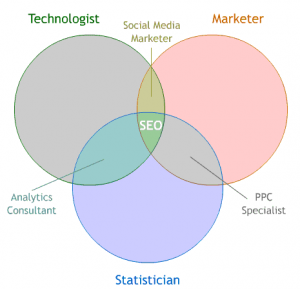
I’m sure everybody’s familiar with the old adage about all problems being nails if you only carry a hammer. Sadly, that thinking doesn’t just apply to carpentry; it also runs rampant in the SEO industry. Many SEOs become so focused on search that they often ignore the other tenants of marketing – or worse, they never bother to learn about marketing in general.
I’m a big proponent of being well rounded. Just as it is extremely important for an SEO to know HTML and CSS, it’s equally important for an SEO to have a basic understanding of marketing and business. Unfortunately, not many SEOs bother to stray from their main focus. It’s too bad.
Jennifer Laycock has a nice retort to Rand Fishkin’s piece about using Google personalized results in advertising.
In my opinion, they both slightly miss the point.
Rand talks about the famous 2007 Pontiac super bowl commercial where they say “Google Pontiac” and “discover for yourself…”
Put aside the irony of using a now defunct company to talk about successful advertising and let’s dive deeper into the ad.
Rand uses this example to talk about personalizing a user toward a domain. Jennifer points out why that strategy isn’t really optimal (Seriously, go read both articles…They open in new windows…. I’ll wait.)
They both make great points (even though I’m going to side with Laycock here) but they both fail to understand the real purpose of the ad.
See, car industries operate in multiple tiers of advertising. They have their top “brand awareness” tier, a “competitive conquest” tier, some middle tiers like getting custom neon signs for their dealership, and the lower “dealer focused” tier. None of these are official names, and I’m certain they differ from car company to car company, but you get the idea.
Believe it or not, most car ads are targeted toward a specific “persona type” who is likely to be in one of the tiers. This is all marketing 101 and clearly covered in marketing for dummies.
Different ads are shown to users based on where they are in the buying process. It starts with brand awareness, changes once the customer has a vehicle in mind, and changes again once they actually want to purchase it. Then there’s the whole idea of marketing to your own customers. If you are interested with customer buying behavior, you may consider visiting the Challenger homepage to know more on this. Consider practical promo tools something consumers will use as well as novelty items to make them smile. You can use Artik promo products as a subtle reminder to customers of your services and to thank them at the same time.
So imagine you have a 30 second super bowl ad. Who do you go after? Do you introduce a new model car, or do you focus on conquest by comparing that car to a competitor’s model? Do you simply build brand awareness? What about the current offers and incentives? You certainly can’t fit it all into a 30 second commercial.
Or can you?
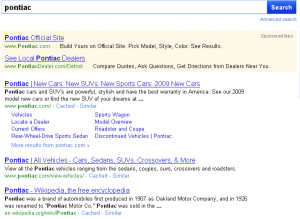
If we look at the screen shot above, we can see all of those tiers clearly represented. The search results not only offer to take me to the Pontiac home page, but I also get results for local dealers where I can go test drive one. There’s a build and price link right there, and there’s also an option to view offers and incentives. All of the bases are covered.
Unfortunately I don’t have a screen shot from the 2007 super bowl, but I’m willing to bet that there were multiple paid campaigns running at that time to address the different segments as well.
From a non-SEO perspective, the marketing strategy was twofold. First, they was a subtle “hey, don’t take our word for it, go look on Google” theme to build trust among the users. Second, they managed to throw a broad ad out there that appealed to all of their pre-defined marketing personas. By going broad Pontiac was theoretically able to capture a larger segment of viewers. If they had gone the vehicle specific route and chosen a sedan, then they would have instantly cut the potential reach of their audience (as those interested in crossovers would have been lost.)
The “Google Pontiac” ad (to me) was nothing more than a shotgun in the dark approach. It was all about maximizing that 30 seconds to reach and captivate the largest potential audience – an approach that can be hard to understand when you only look at Google from a search marketing point of view.
Let this serve as a good reminder that occasionally we need to take off our SEO hats (white or black) and look at things from a general marketing and branding point of view as well. Scaffolding Wrap Advertising is also effective if you want to stand out in a crowded marketplace.
February 8th, 2010
You’ve probably seen the tweet on twitter claiming “Digg Hacked – Screenshot coming soon” and have been furiously searching Twitter and Digg for “digg hacked” trying to find out what’s going on.
Well, you’ve been had by a new marketing campaign. Digg wasn’t hacked.
If you look at the source code of Digg, you’ll see an ASCII art that looks like the following:

This is the supposed Digg hack, but a closer inspection reveals that there’s a URL and password embedded in the bottom of the ASCII art. That URL takes you to http://www.hellisnigh.com/ – a mere ad for the upcoming Dante’s Infero movie. There’s even a password in there for you to enter on 2.09.10
It turns out Digg wasn’t hacked at all, but that didn’t matter. All it took was for somebody to say something on twitter and everybody else furiously retweeted it and bought into the “digg hack hype” I’m sure whoever started this is close to setting a new record for retweets and followers per tweet.
Kudos to whatever marketing firm came up with this idea. It’s truly original and unique – now excuse me while I run to Tweet about “Miley Cyrus sex tape found – screenshot coming soon.”
February 3rd, 2010

Last month I talked about why having 1000 twitter followers doesn’t make you a social media guru. I got some great feedback, but one of the questions somebody asked me was “Ok, if it’s not about followers, what is it about?”
My reaction was nothing more than a facepalm.
It’s not about followers you idiot, it’s about engagement!
I can’t believe more social media mavens haven’t figured it out yet. (and yes, Nick I still think maven is feminine)
I’m going to let you all in on a little social media secret: It’s not about how many followers you have or even rating those followers; it’s about how you and your followers engage. It’s such a simple concept, but very few people actually understand it.
In fact, most people who are currently classified as “social media gurus” fall into one of the following categories:
1. They don’t engage at all. A good example here is your favorite band on facebook or Twitter. How often do they actually respond to fans or leave comments on their own posts? Most don’t. Some (I remember having a convo with Adam Duritz ) do, but in general most bands simply leave Twitter and Facebook to their PR teams or labels.
2. They only engage other A-listers. I’m not going to call people out here, but just go look at your favorite celebrity’s tweets. Most of them are only to other celebrities. This thing goes on a LOT in the SEO community too – where many A-list SEO people only reply to each other.
3. They treat their twitter and facebook like a press release. This is what happens when legal gets involved or marketing and PR end up supervising a social media person. Believe it or not customers DO want to year your PR pitches, but they want to hear them from an actual person – not a faceless corporate entity.
Then there’s category 4 – the people who actually understand engagement and get it right. There’s tons of these people out there, but they don’t go around calling themselves gurus.
See, followers are useless unless they actually click on links, respond to questions, and generally give a shit about what you’re saying. Go ahead, try asking a question on Twitter and see how many people answer you. You may be surprised.
Ok, that’s great, but how do I measure engagement?
I’m glad you asked. Forrester breaks the measurement of engagement down into 4 categories: Involvement, Interaction, Intimacy, and Influence.
This model is a bit different from the current “Earned, Bought, Owned” one being thrown around, but I find it much more useful. EBO is great for measuring where you’re spending your social media efforts but it comes up lacking in the measurement department.
So what is IIII?
Involvement refers to the standard metrics I’ve been discounting in my last few blog posts. Put simply, involvement measures presence. Things like Followers, RSS subscribers, Friends, etc fall into this category. As I’ve been saying before though, they’re just the tip of the iceberg.
Interaction refers to actions that people take. Things like @replies, blog or video comments all fall into this category.
Intimacy is nothing more than a measure of a person’s affection. Retweets, Thumbs up, Diggs, Sphinns, Shouts, and Votes all fall into this category.
Influence is just what it says. It’s the likelihood of somebody advocating you or your brand. Retweets, reviews, and suggestions are great ways to measure this.
That’s how to measure engagement, and that’s why social media is more than just followers.
To extend my previous analogy: Your huge follower-related e-penis may give you great influence, but you can’t can’t achieve intimacy with a giant e-penis alone. Interaction and Involvement are where your e-penis can make the biggest (giggle) impact.
February 2nd, 2010
I keep seeing the same mistake being made over and over: Companies keep choosing their social media department based on how many Twitter followers or Facebook friends they have.
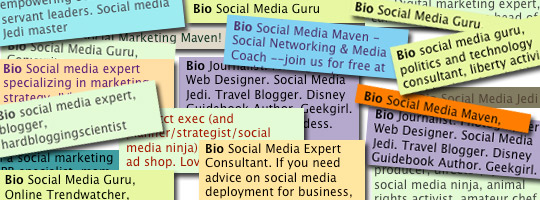
It starts when an executive hears of social media and decides that his company needs an offering in that space. The executive soon discovers that nobody really has any experience in social media, but they’ve got to pick somebody. It’s then that you can see them frantically running around the office asking “Who’s got a Twitter account?”
In a world where we have metrics for everything it can be easy to simply look at friends or followers as a metric for determining social media prowess – and that’s where companies get into trouble.
Twitter and Facebook friend counts are nothing more than an elaborate measurement of virtual penis size. That’s really all they’re good for. I’ve talked about why friend counts are bad years ago, but nobody was even talking about social media back then. (those problems still exist by the way.)

The bigger problem with friends is engagement. As I discussed last year, the reason twitter bots are so effective is that people blindly re-follow anybody who follows them. If I want to get 1000 facebook friends I simply have to go friend request about 5000 people. It’s a safe bet that 1/5 of them will approve my request. That percentage is even higher on Twitter. In my tests I’ve seen about a 40% re-follow rate.
Engagement is what matters. How many of your followers actually reply to you? How many of them comment on your posts? What percentage click on links that you tweet? Go ahead and ask your social media person – I bet they don’t have any answers for you.
It’s not just companies that are falling into the “friend fallacy” though – individuals are even more to blame. Just look at how people describe themselves on their twitter biographies and you’ll see what I’m talking about. There’s a plethora of self proclaimed gurus out there. (personally, I prefer to call myself an expert rather than a guru.)
In fact, many of the people I consider experts (myself included) are taking an opposite approach to followers. Not only do I not follow people back unless they’re interesting, but I also block the spam bots and low-quality accounts from following me. It keeps my followers and people I’m following low, but it also keeps them highly engaged. My signal to noise ratio is great too. You won’t find many other people who do this though, as they like to point to that high friend count to re-enforce their “guru” status.
Whenever somebody professes to be a social media guru I always ask them the same questions: How much money are you making from Twitter? What’s the lift generated by your Facebook account? What metrics are you using?
Many social marketers will quickly change the subject when you start talking about actionable analytics and ROI – and for good reason too. See, the fact is that many of these Gurus have no idea how to measure their contribution to social media nor do they want to. Measuring their value may just show them how small their virtual penis actually is.
Social media, like all marketing campaigns, needs to be well thought out. You should have a clear goal, a plan in place to achieve that goal, and a method of measuring the results. Plus, it can take a long time to growing a following of real people if you don’t buy tiktok views for your TikTok posts.
Just like you wouldn’t undertake an advertising initiative without a plan, you wouldn’t hire an advertising agency based on “number of dollars they spent” or a PR person based on “number of press releases submitted,” so why on earth would you hire a social media person based on how many friends or followers they have?
It’s time we stop comparing the size of our virtual penises and start looking at metrics that matter. Besides, we all know that my e-penis is bigger than yours anyway.
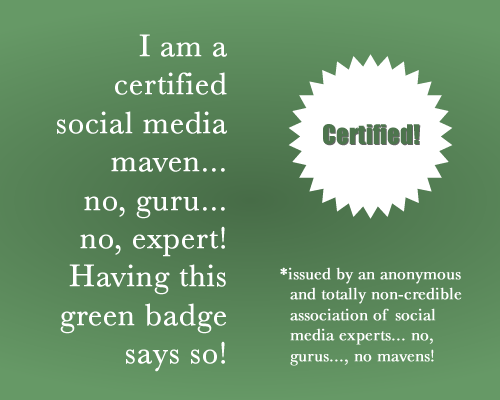
January 13th, 2010
Lot’s of people are busy talking about Twitter’s growth and their journey to profitability. There’s plenty of discussion about new features and lots of questions about business models, but nobody’s talking about what the future Twitter account might look like. I’ve got a few ideas, and they don’t bode well for Twitter’s business model.
If you follow me on Twitter you’ll know that I recently picked up a WiThings Scale. If you don’t, the WiThings scale is a scale with a wifi card built in. It automatically tweets out my weight every time I step on it. It even keeps shareable graphs of my weight so that everybody can see how Fat I’m getting. Since you’re all curious I’ll go ahead and share it here:
So what am I getting at? Well, my scale tweets. My foursquare account Tweets every time I check in somewhere. My Blippy account will soon Tweet every time I make a purchase. DailyBooth Tweets every time I upload a picture. Do you see where I’m going here?
A good percentage of my Tweets will soon be auto-generated by other services that I use. My Twitter account is taking “what are you doing” to the next level and not even requiring me to tell it what I’m doing. It just hooks into everything else and does the rest.
Twitter is becoming less of a social network and more of a social infrastructure. Entire new startups are popping up that use Twitter as an underlying platform. There’s a shifting trend away from using APIs and instead just hooking up services via twitter. It’s insanely easy to post to and read from Twitter, and posting publicly even builds more awareness for your application; so why not use Twitter instead of a private back end connection?
It won’t be long until a good percentage of everybody’s tweets will be auto generated from some other service. What will happen to Twitter then? Will we still monitor it the way we do now, or will we simply rely on some other application to pull in the data and filter it for us? I’m betting the latter.
It’s only a matter of time before everything in my house is Tweeting. The TV will tell you what I’m watching, iTunes will tweet what I’m listening to, Xbox will tweet my kill/death ratio in Call of Duty, and Graywolf’s oven will tweet what’s cooking and how long until it’s done.
In fact, I wonder how hard it would be to hook up a wifi card and volume displacement gauge to my Toilet…..
January 11th, 2010
If you want to learn how to network as a financial advisor, then you have to start with social networking. I’ve got an account on almost every service you’ve never heard of, and even the ones you have heard of. When a new social media service launches you can bet I’ll have an invite waiting. When somebody at the office has a social media question, I’m the guy they turn to.
But I still haven’t found a social network that does what I want a social network to do.
I list my friends on Facebook. I tell the world what I’m working on at LinkedIn. I tell them what I’m doing on Twitter, where I’m doing it on FourSquare, how much I spent on Blippy, and even show them pictures on DailyBooth. ( feel free to friend me on any of these – except FaceBook – I keep that just to a close circle of friends. )
But why can’t I do all of that on one service?
Let’s take a common chore for example: Business meeting at Olive Garden. To share this event with the world I’d first go to LinkedIn and update my ‘working on.’ Then I’d head over to Twitter and post something like “never ending pasta bowl at olive garden is going to wreak havoc on my new years resolution.” When I got there, I’d check in on the FourSquare app on my iPhone. I may even use my phone to take a picture of my huge plate of pasta and upload it to DailyBooth. When I pay the bill with my American Express card, it will show up on Blippy the next day. All of the details of my trip have been recorded using various social networks, but it was a pain in the ass to track.
Then there’s the whole issue of who I went to lunch with. Everyone has a LinkedIn, but only 2 of the 4 people had a Twitter and I’m only following one of them. They’ve never heard of DailyBooth, and only one other person has a FourSquare account. In fact, he’s the Mayor of that Olive Garden. Tying them all together to the event would be a nightmare. There’s just no way to do it.
What I want is one social network that encompasses all of that. From one App on my iPhone I should be able to snap a picture, type in a description, tag all my friends, and upload it. It will use the GPS to know where I’m at. Anybody following the feed will see a thumbnail of the picture with a “lunch meeting at Olive Garden” description and a nice clickable link that takes them to a full resolution picture, names and links to profiles of attendees, a Google map of the restaurant complete with tips, how much I spent, a place to comment, a listing of all the mentions and replies to this event, and links to other recent events at this place.
It should all be in one place, nice and neat, and fully encompassing all of the details of my lunch experience. Instead, I’ve got it all spread out over various social networks that most of my friends and colleagues haven’t even heard of. Furthermore, I’ve got different login names on some of the services. Sure my Twitter, Blippy and FourSquare are all RyanJones but on LinkedIn I go by Jonesy because it already had a RyanJones. My Facebook name is something completely different. There’s no way an average person could tie them all together if I wanted them to.
So Why Don’t I Build It? While all of this data is technically public, it’s not entirely open. Not all of these services have RSS feeds, Widgets, or APIs that somebody could pull from. Furthermore, I don’t really control any of the data on these services – they do. Trying to hack together a usable service from all of the existing social networks is possible, but not practical; and it doesn’t even begin to address the fact that I’d still need to have an account on each of them.
This is a problem that somebody like Twitter, Facebook, or Google need to address in order to fix. Only they have the reach and user base to truly build an awesome social network. Adding another social network on top of the established ones doesn’t seem like it would solve this problem. Ideally somebody like Twitter needs to grab the horse by the reins and start implementing all of these features. They’ve already got the infrastructure, and all of these features have already been coded by somebody – they just haven’t been properly integrated. Once they’re integrated, then the cool stuff can begin.
Think about not only being able to easily update everything, but about all the information you can glean from updates on such a system. Who else bought what I’m buying, where did they buy it? did they get a better deal? I mentioned all of that earlier on my Blippy post, but you can take it to the next level when you incorporate more data than just pricing.
Sure, it may seem pretty lame when I talk about lunch at Olive Garden, but what about events like SES where tons of people are all thrown upon an unsuspecting downtown area for a few days? You could get some pretty cool who’s doing what with who when and where style recommendations. In a new town? No problem, show me what other people who came here also did. Oh, wow people who ate at this pizza place also caught a movie at this cinema? People who ate at this chic BBQ joint also visited this bar and later rented this movie on Netflix? I should check that out. (NetFlix doesn’t realize it yet, but they’re sitting on a huge social network potential too.) You can easily see where this is all going. Then there’s all the new possibilities involving new kinds of ad targeting. Done right this system could be a marketer’s dream AND provide useful, relevant ads that people actually want to see.
Social media right now is fun, but only when you put it all together do you unlock the true potential. I’m rather excited to see where social media goes in the next few years. One thing is for sure though: wherever it does go, I’ll be there.
January 5th, 2010
So I’ve been playing with Blippy over the holiday break and while I find it to be pretty fun, I think it’s missing a few features that can make it really useful.
If you haven’t heard of Blippy yet, I’d sum it up by saying it’s Twitter for purchases. Basically, you tell Blippy your Amazon, Netflix, Blockbuster, iTunes, GoDaddy, WineLibrary, Zappos, Audible, SeamlessWeb or Credit Card information and it then automatically posts updates of what you bought and how much you spent on it.
If you already have a Blippy account, my username is RyanJones
Yes I know it’s just another way to compare e-penis size, but it’s actually pretty cool to see what people like Matt Cutts and Jason Calacanis are actually buying wasting money on.
Here’s a screenshot of some of my recent purchases. The red boxes are mine, I’ll explain why below the picture.
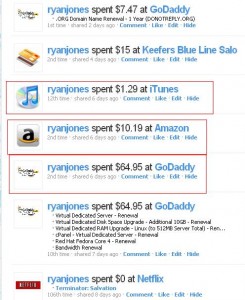
You can see here that Blippy pulled in data from my Netflix account (I still haven’t watched that movie yet) my GoDaddy account, and my iTunes account. If you look closely though, you’ll see two charges to GoDaddy for $64.95 That’s for one of my servers. In reality, I only paid that $64.95 once – but since I added both my GoDaddy account AND the credit card that’s tied to it to Blippy, Blippy is reporting it as two different purchases. It doesn’t know that the $64.95 charge from GoDaddy and the later $64.95 that shows up on my credit card are in fact the same purchase.
Since I use that same card on Amazon and iTunes, Blippy is also double reporting those purchases. One solution might be to simply just tell Blippy about my credit card and nothing else, but then it won’t show the details of the Amazon and GoDaddy purchases. Likewise, if I remove my credit card then you won’t be able to keep tabs on my bar tabs. Hopefully Blippy figures out a way to treat these double purchases soon.
Other Features I’d Like:
I’d like the ability to make my profile public so that even people without Blippy accounts can see it. Blippy is still invite only and doesn’t have many users. By letting people make their accounts public, they could probably build up a lot more interest.
I’d also like widgets! I want to show my purchases on my blog, but without even so much as an RSS feed I’m stuck.
It would also be cool if Blippy could cross post to Twitter and FriendFeed.
They’re probably already working on it, but I want Netflix style recommendations. If I bought something on Amazon, I want to see stuff like “3 followers also bought this” and “people who bought this also bought this thing here…” That could be extremely useful when it comes to things like video games, books, or music.
I want stats! Mint.com does a great job of tracking my spending so I don’t need too many details out of Blippy, but some basic spending stats broken down by date and website would be pretty neat.
Overall, I think Blippy could be a fun service. Right now it just needs more users and features to get it to that point. It’ll be interesting to see where it goes from here.
By the way, if you’ve made it this far, I still have a couple of Blippy invites left that I can give out. If you want one, and I know you, feel free to leave a comment here. Make sure you put your real email (it won’t show on my blog, but I’ll use it to send the invite)
January 4th, 2010
Forgive me for going mommy blogger for a minute, but I had an interesting conversation last night with a friend about believing in Santa Claus. It’s a worldly tradition that we blindly pass on from generation to generation without stopping to actually think about it.
Is believing in Santa bad for a child? Sure it may seem like lots of innocent fun, but think back to the day you learned the truth about Santa. Maybe you woke up in the middle of the night and saw Dad putting out presents. Perhaps it was your peers making fun of you in elementary school. Or, perhaps you were that kid in middle school who still believed and everybody made fun of behind your back. We had one of those kids, and he didn’t turn out too well.
How devastating was it when you realized that everybody – your parents, friends, family, tv – was blatantly lying to you? It’s probably one of the saddest memories of everyone’s childhood.
So why do we put our kids through this? As a parent, you are your child’s model for God. For the first few years of that child’s life her parents are the most perfect people she knows. Now, imagine what it’s like when she finds out her godlike parents lied to her. She’s got to be crushed!
Isn’t it much better to instead teach our children about the benefits of giving?
Of course, then there’s the whole Santa as a bad influence. Here’s a fat, pipe smoking man who spends his time watching little kids (creepy) while forcing minorities (elfs) to work under slave like conditions in an inhospitable climate. This is the type of shit that goes on in China and Africa, not the type of bedtime stories we should tell our kids.
And what about the kids who won’t have a Christmas because they either aren’t christian or their families just can’t afford it. How do you explain to those kids that Santa visits all of their friends but not them. They’re too young to understand religious differences, and they’re still likely to be upset when their friends talk of all the gifts they’ve received from this magical man who shunned them.
During our conversation we decided that should we ever get really really drunk and somehow produce offspring together, that we wouldn’t let them believe in Santa. Instead, we’d teach them about the benefits of giving and doing good for others. The only challenge with that though, is preventing our own kids from ruining christmas for other kids – as that job belongs to their parents.
December 18th, 2009
Next Posts
Previous Posts











